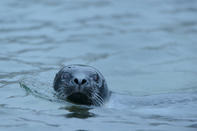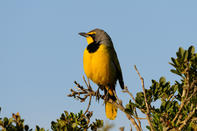Alexandria Trail and Woody Cape Dunes
Woody Cape, which in recent years has been included as the coastal part of the Addo Elephant National Park, is said to be the largest coastal dune field in the world. That might or might not be true, but it does stretch for 40 km to the Sunday's River. Add the extra 25 km from the Sunday's River to Swartkops estuary and you've got one very large sandpit.

The first day of the trail is through the Alexandria Valley bushveld forest inland, the dunes are walked on day two of the Alexandria Trail at the Addo Elephant National Park. It's one of the country's best overnight trails, and it's fun to explore the dunes from the Sundays River mouth. You can choose how far you want to go; with luck, you might see whales, seals, sea birds and whale skeletons.
Birding in Addo Elephant National Park

Find a comfortable spot in the main camp at Addo Elephant National Park - some 270 bird species have been found there alone. Birds are not easily seen in the park’s thick spekboom (Portulacaria afra) vegetation unless attracted to an abundant food source, such as the Karoo boer-bean (Schotia afra), which may lure up to four species of sunbird.
Areas of seeding grass attract blue-billed firefinch, sweet and common waxbills, while Karoo robins are often seen flashing across the roads. Enjoy the hides and follow the paths through the grasslands of the Addo Elephant National Park.
Detour to Zuurberg Mountain Pass

If you feel like a drive outside the Addo Elephant National Park, exit the reserve gates and follow signs to the old gravel road up the Zuurberg Pass. This is a little-used mountain road with great views out over the countryside.
At the summit of the pass, you can enjoy a spot of tea at the historic Zuurberg Mountain Inn, outside the Addo Elephant National Park. This is a delightful old boarding house, with much of its colonial charm intact, despite its many incarnations. Once down the other side of the Zuurberg, you can continue on gravel to Somerset East, or you can turn right onto a beautiful back road through the aloes, to rejoin the tarred N10, above the town of Paterson.
The Zuurberg Pass has a long history, and its dusty course bears testament to the controversial ambush of Andries Stockenstrom during the Anglo-Xhosa Frontier Wars. It was also a main highway to the interior during the days of the Kimberley diamond rush.
 There’s no better way to enjoy your Accommodation in Addo Elephant National Park than with a sundowner sitting on your stoep and watching,...
There’s no better way to enjoy your Accommodation in Addo Elephant National Park than with a sundowner sitting on your stoep and watching,... The Eastern Cape Coastal Route covers the length of the Eastern Cape Province stretching across a number of districts. The route starts at T...
The Eastern Cape Coastal Route covers the length of the Eastern Cape Province stretching across a number of districts. The route starts at T...